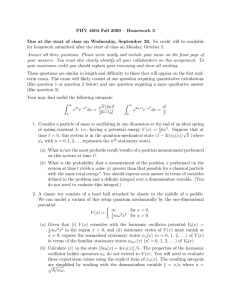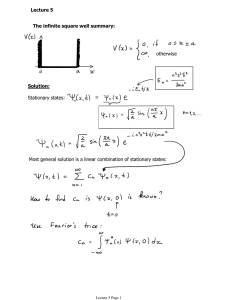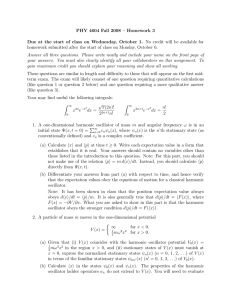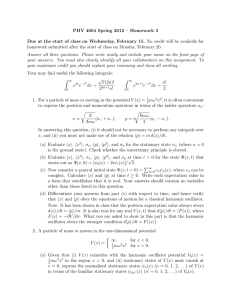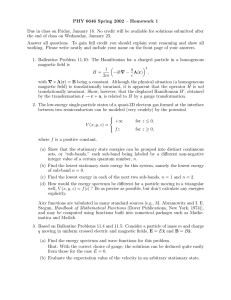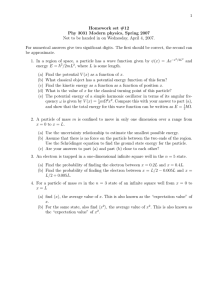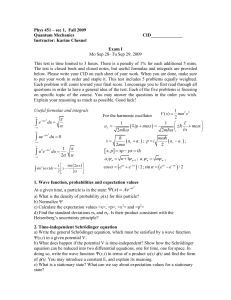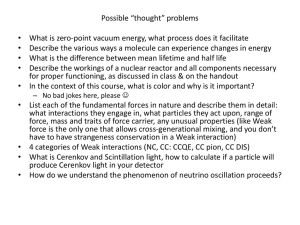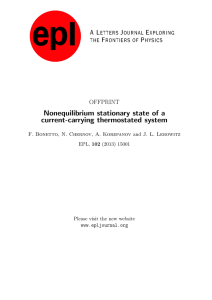PHY 4604 Fall 2010 – Homework 3
advertisement
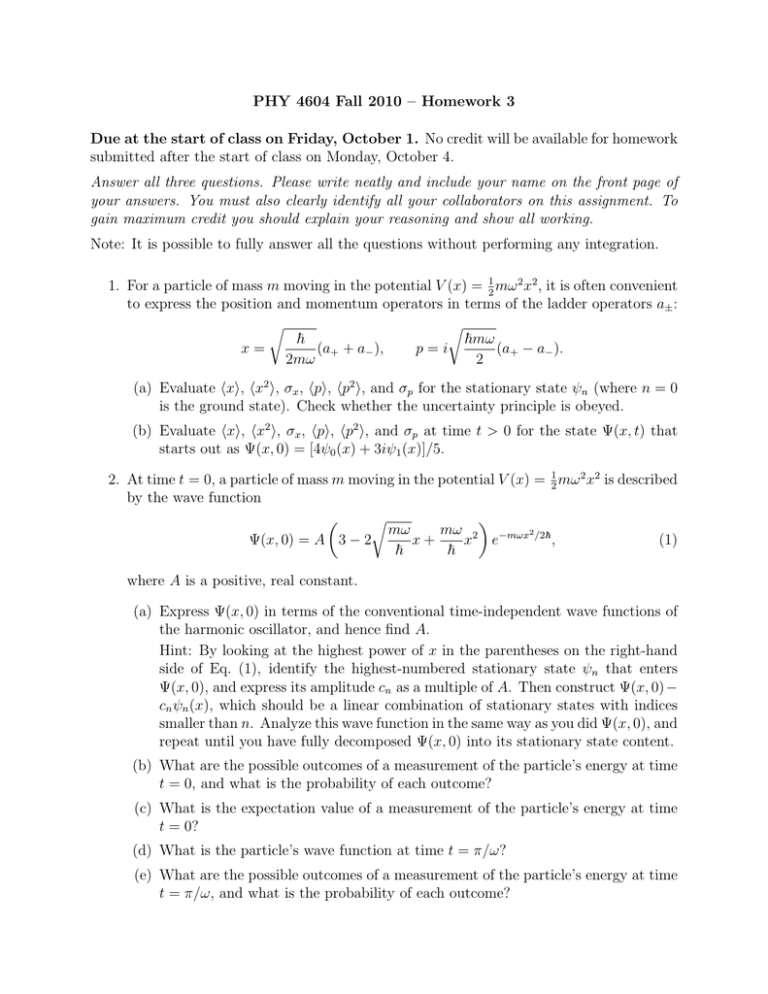
PHY 4604 Fall 2010 – Homework 3 Due at the start of class on Friday, October 1. No credit will be available for homework submitted after the start of class on Monday, October 4. Answer all three questions. Please write neatly and include your name on the front page of your answers. You must also clearly identify all your collaborators on this assignment. To gain maximum credit you should explain your reasoning and show all working. Note: It is possible to fully answer all the questions without performing any integration. 1. For a particle of mass m moving in the potential V (x) = 12 mω 2 x2 , it is often convenient to express the position and momentum operators in terms of the ladder operators a± : r r ~ ~mω x= p=i (a+ + a− ), (a+ − a− ). 2mω 2 (a) Evaluate hxi, hx2 i, σx , hpi, hp2 i, and σp for the stationary state ψn (where n = 0 is the ground state). Check whether the uncertainty principle is obeyed. (b) Evaluate hxi, hx2 i, σx , hpi, hp2 i, and σp at time t > 0 for the state Ψ(x, t) that starts out as Ψ(x, 0) = [4ψ0 (x) + 3iψ1 (x)]/5. 2. At time t = 0, a particle of mass m moving in the potential V (x) = 12 mω 2 x2 is described by the wave function r mω mω 2 −mωx2 /2~ Ψ(x, 0) = A 3 − 2 , (1) x+ x e ~ ~ where A is a positive, real constant. (a) Express Ψ(x, 0) in terms of the conventional time-independent wave functions of the harmonic oscillator, and hence find A. Hint: By looking at the highest power of x in the parentheses on the right-hand side of Eq. (1), identify the highest-numbered stationary state ψn that enters Ψ(x, 0), and express its amplitude cn as a multiple of A. Then construct Ψ(x, 0)− cn ψn (x), which should be a linear combination of stationary states with indices smaller than n. Analyze this wave function in the same way as you did Ψ(x, 0), and repeat until you have fully decomposed Ψ(x, 0) into its stationary state content. (b) What are the possible outcomes of a measurement of the particle’s energy at time t = 0, and what is the probability of each outcome? (c) What is the expectation value of a measurement of the particle’s energy at time t = 0? (d) What is the particle’s wave function at time t = π/ω? (e) What are the possible outcomes of a measurement of the particle’s energy at time t = π/ω, and what is the probability of each outcome? (f) What is the expectation value of a measurement of the particle’s energy at time t = π/ω? 3. Consider a particle of mass m moving in one dimension under the influence of a doublestep potential x < −a, −V0 0 −a < x < a, V (x) = x > a, V0 with V0 = π 2 ~2 /ma2 . (a) List the range(s) of energies E (if any) within which you expect stationary states to be (i) forbidden; (ii) allowed at discrete energies only; (iii) allowed at all energies within the range; (iv) doubly degenerate. (b) List the range(s) of energies E (if any) within which you expect to be able to construct stationary states having a nonzero probability current. The remainder of this problem concerns a particular stationary state of this problem: one of energy E = V0 /2, having a wave function ψ(x). Answer the questions below using qualitative arguments wherever possible. It should not be necessary for you to obtain a full quantitative solution for ψ(x). (c) Write down the form of ψ(x) in the region x > a. Express the wavelength or exponential decay length (whichever is appropriate) of ψ(x) in this region as a multiple of a. (The exponential decay length is l in e−x/l .) Show that the probability current vanishes in this region. (d) Write down the form of ψ(x) in the region −a < x < a. Express the wavelength or exponential decay length of ψ(x) in this region as a multiple of a. What is the probability current in this region? (e) Write down the form of ψ(x) in the region x < −a. Express the wavelength or exponential decay length of ψ(x) in this region as a multiple of a. What is the probability current in this region? (f) Based on the analogy with classical mechanics, explain whether you expect the maximum amplitude of ψ(x) in the region x < −a to be greater than, less than, or equal to the maximum amplitude of ψ(x) in the region −a < x < a. (g) Sketch a graph of the probability density |ψ(x)|2 as a function of x. The horizontal axis should range from x = −3a to x = 3a, and should have the points x = −a and x = a explicitly labeled. You should be careful to represent correctly as many features of the graph as possible (based on the information derived in the previous parts of the problem).
